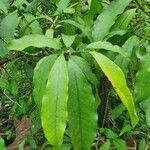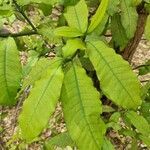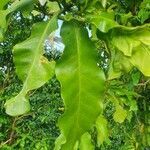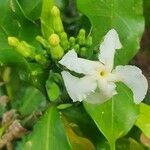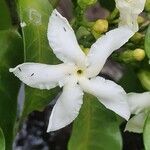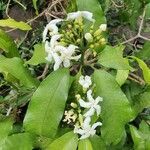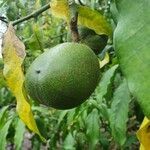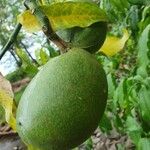Corolla white, with a pale green tube and often with a pale yellow throat, thickly carnose, in the mature bud with a ventricose tube and a comparatively large ovoid head formed by the lobes (being conspicuously wider than the tube and c. 1/3–2/5 of the length of the bud, with a subacute point), outside glabrous or with a small patch of pubescence at the left side of the base of the lobes (and occasionally with 5 stripes 7 mm. long of pubescence on the tube below), inside pilose in a belt stretching from 6 mm. below to 2 mm. above the insertion of the stamens and ending barely below the mouth or reaching the base of the lobes; tube 3–4·5 times as long as the calyx, 21–42 mm. long, almost cylindrical, not angular, at the base 2·5–5 mm., ventricose at the insertion of the stamens or barely below and there 5·5–9 mm., above 3·5–6 mm. wide, 0–1/4 turn twisted over the entire length of the tube; lobes not always falcate, 0·7–1·8 times as long as the tube, 1·5–2·3 times as long as wide, 17–50 x 8–24 mm., rounded, not or obscurely auriculate at the left side of the base, undulate, spreading and recurved later.
Leaves petiolate; petiole glabrous, 5–30 mm. long; lamina coriaceous (also when fresh), variable in size, mostly narrowly elliptic, 2–4·5 times as long as wide, 12–40 x 3–14 cm., acuminate, apiculate, or rounded, at the base cuneate or decurrent into the petiole, entire or sometimes sinuate, often with slightly revolute margins, glabrous on both surfaces; secondary veins 12–24 on each side of the midrib, fairly straight at the base, upcurved, forming an angle of 70–90° with the midrib.
Pistil glabrous, 13–17 mm. long; ovary almost cylindrical, 4–6 x 2–4 x 2–3 mm., tapering into the style; style 5–10 x 0·8–1 mm., slightly widened at the apex; clavuncula almost cylindrical, 2–4·5 mm. long, at the sides obscurely 5-angular, and at the base widened into a 1·5–3 mm. wide ring, in the middle 1–1·2 mm. in diam., at the apex widened into 5 subcircular lobes altogether c. 1·2–1·7 mm. wide; stigma bilobed, 0·2–1 mm. long obtuse or acute.
Mericarps separate, dark green, with pale green, white, or yellow dots, very big, subglobose, 10–20 x 8–20 x 8–20 cm., rounded, with an indented line of dehiscence, but probably indehiscent, several-to many-seeded; wall on section and inside white(?), 2·5–6 cm. thick; aril white(?).
Sepals medium green, almost free, thick, carnose, erect, subcircular to oblong, 1–1·5 times as long as wide, 5–7 x 4–7 mm., often ciliate, outside glabrous, inside closely together in the middle of the base with one row of 6–10 large colleters (1)1·5 x 0·3–0·5 mm.
Stamens 2–15 mm. included, inserted at 1/3–1/2 of the length from the base of the corolla tube (being at 11–15 mm. from the base); anthers 9–12·5(17) x 3–4 mm., glabrous.
Branches shallowly longitudinally fissured when dried, with large lenticels of the same colour, with conspicuous leaf scars; branchlets glabrous.
Seeds dark brown, 15–21 x 9–12 x 7–10 mm., with longitudinal and transverse or oblique grooves, with a minute honeycomb-like structure.
Tree 5–25(35) m. high; trunk terete, 25–90 cm. in diam.; bark pale to dark grey–brown, rough (?), 1 cm. thick, corky.
Inflorescences often long–pedunculate, 10–28 x 7–15 cm., few-to many-flowered, fairly lax.
Bracts scale-like, much smaller than the sepals, with a row of colleters in the axils.
Peduncle glabrous, 3–15 cm. long, fairly robust.
Flowers sweet-scented, open in day time.
Pedicels glabrous, 5–30 mm. long.
Ovules 100–200 in each carpel.
